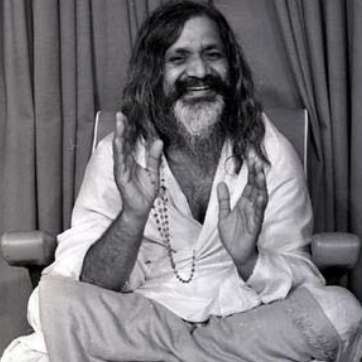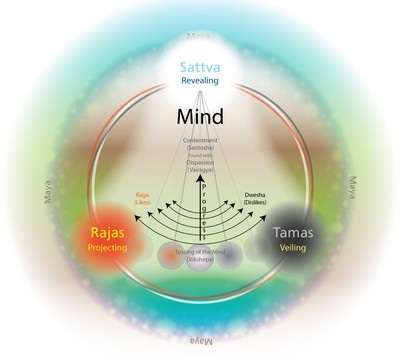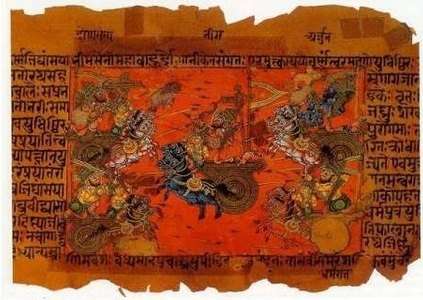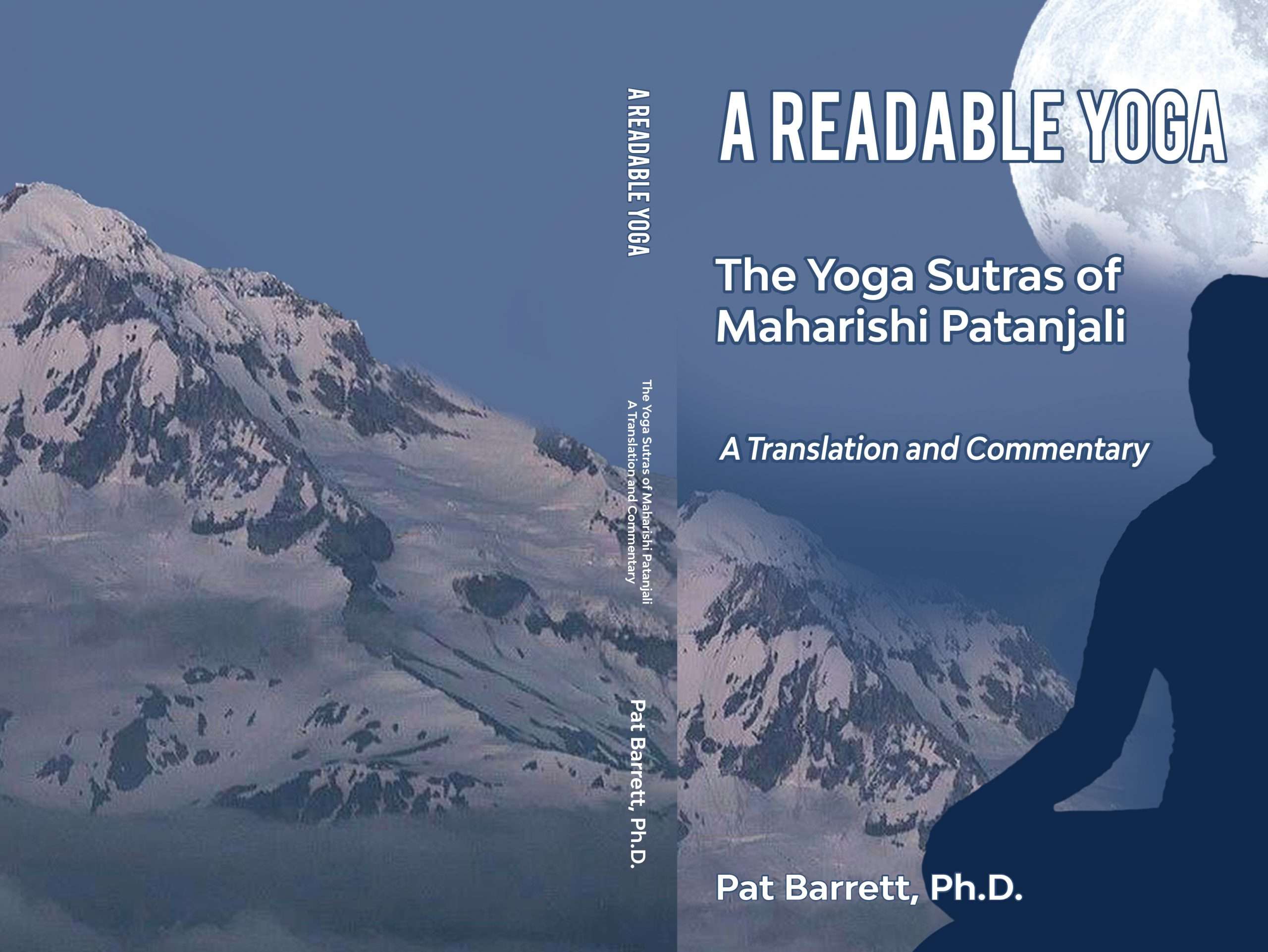In itself, The Bhagavad Gita is a profound, powerful and inspiring text. Arjuna, a warrior about to lead his army into battle where both fighting sides contain his loved ones turns to God for advice. Should he, in these circumstances, engage in warfare or avoid it? By this situational allegory, the text touches upon the most essential questions, challenges and lessons in life.

One of the talents of Maharishi Mahesh Yogi, a great Indian sage and visionary, was his ability to speak to people using simple metaphors and everyday language. In his translation and commentaries on the ancient Vedic scripture, Maharishi went to the very heart of Lord Krishna’s teachings. His aim was to restore the real depth and fundamental importance of The Bhagavad Gita for the people living in the modern scientific world.
Here is a chapter by chapter overview of Maharishi Mahesh Yogi’s commentary.
THE BHAGAVAD GITA:
COMMENTARY ON CHAPTER 1
PREPARING THE GROUND
Maharishi Mahesh Yogi: “This chapter prepares the ground and sets the scene for the glorious dialogue of the Lord’s Song, the Bhagavad-Gita. Although it does not contain the actual discourse of the Lord, which really begins in the second chapter, it presents the basic problems of life and gives Lord Krishna the chance to propound the philosophy and practice which enable man to live his life free from suffering.”
Although Krishna speaks only very briefly to Arjuna in this opening chapter, Maharishi claims that this short uttering establishes the soldier Arjuna on the ground of love and lifts his consciousness to a more open, more pure and receptive state of alertness. This is a necessary step towards the wisdom of the Absolute, the timeless message of life offered to him shortly.
Maharishi Mahesh Yogi: “[Arjuna’s enemy on the battlefield] Duryodhana, seeing his own army and the army opposing it drawn up on the battlefield, gives the signal for battle. And Arjuna, the greatest archer of his time, thoughtful and conscientious, resolved to oppose evil yet overflowing with a wave of love, visualizes the consequences of war and reaches a state of suspension between the dictates of his heart and mind. This situation, where consciousness is in a state of suspension, where both the mind and the heart are on the highest level of alertness, provides the ideal occasion for the divine intelligence to overtake and shape the destiny of man.

“Life is a battlefield of opposing forces. He who, like Arjuna, has recourse to divine intelligence receives the light and shares the cosmic purpose of fulfillment both for himself and others. But he who is trapped by temptation, like Duryodhana, becomes a drag upon life; he retards his own evolution and also hinders the progress of others.”
THE BHAGAVAD GITA:
COMMENTARY ON CHAPTER 2
THE ESSENCE OF WISDOM
Maharishi Mahesh Yogi: “This chapter is the soul of the Bhagavad-Gita, while all those that follow form the body. Hope and fulfillment are the blessings of this glorious chapter. It gives a direct way to peaceful, energetic and successful life in the world, together with spiritual comfort and freedom from bondage.”
This central chapter of the scripture explains the whole concept of Brahma Vidya – the wisdom of the Absolute in all of its theoretical and practical aspects. In spite of this scope and depth, however, Maharishi states that the chapter can speak to every reader, whether she / he be a novice seeker or an accomplished sage.
The key to the wisdom of life is, according to Maharishi, revealed in the 45th verse of the chapter:
The Vedas’ concern is with the three
gunas. Be without the three gunas,
O Arjuna, freed from duality, ever
firm in purity, independent of possessions,
possessed of the Self.
Maharishi Mahesh Yogi: “This is the technique of instantaneous realization. /—/ Everything that has so far been said by Lord Krishna is to prepare Arjuna to understand this practice of bringing his mind from the field of multiplicity to that of eternal Unity. This practice is to brighten all aspects of his life by bringing his mind to transcendental consciousness, the limitless source of life, energy, wisdom, peace and happiness. It is to raise him to that cosmic status which harmonizes all the opposite forces of life.”
The secret here is not to delve into a laboured investigation of the causes of a problem in order to achieve a desired effect. What The Bhagavad Gita is teaching us is the technique of introducing a new, second element – remove the darkness not by searching for its cause, but by bringing in light.
“It is this completeness of practical wisdom that has made the Bhagavad-Gita immortal,” explains Maharishi in his commentary. “Lord Krishna commands Arjuna: ‘Be without the three gunas’; be without activity, be your Self. This is resolute consciousness, the state of absolute Being, which is the ultimate cause of all causes. This state of consciousness brings harmony to the whole field of cause and effect and glorifies all life.

“Arjuna’s main problem was to reconcile love of kinsmen with the necessity to root out evil. He was desperately seeking a formula of compromise between righteousness and evil. But on any plane of relative life these are irreconcilable. That is why, having explored all the avenues of his heart and mind, Arjuna could not find any practical solution, could not decide on any line of action. Lord Krishna, however, shows him the field where righteousness and love merge in eternal harmony, the eternal life of absolute Being.
“The Lord makes clear to Arjuna that all influences of the outside world, and their consequences as well, will cling to him and affect him so long as he is out of himself, so long as he allows himself to remain in the sphere of relativity and under its influence. Once out of that sphere, he will find fulfillment in his own Self.”
To clarify the meaning of this, Maharishi brings in an example: think of a businessman, he says. As long as he is immersed in all the details of his ventures, he will not be able to really improve the whole of his undertakings. But as soon as he distances himself for awhile, he can easily grasp what steps to take next.
The solution is thus always within oneself, provided that one knows how to be without the three gunas — posessed only of the Self.
Maharishi Mahesh Yogi: “The entire creation consists of the interplay of the three gunas – sattva, raja and tamas – born of prakriti, or Nature. The process of evolution is carried on by these three gunas. Evolution means creation and its progressive development, and at its basis lies activity. Activity needs rajo-guna to create a spur, and it needs sato-guna and tamo-guna to uphold the direction of the movement.
“No one guna can exist in isolation without the presence of the other two. It is for this reason that Lord Krishna asks Arjuna to be out of all three gunas, to be entirely out of the influence of the forces that constitute life in the relative field.

“While giving him the wisdom of Sankhya, the Lord has told Arjuna that there are two aspects of life, perishable and imperishable. The perishable is relative existence, and the imperishable is absolute Being. All life in the relative field is under the sway of the gunas. Therefore, in order to give Arjuna the direct experience of the absolute state of life, Krishna asks him to be without the three gunas.
“Once you are possessed by your Self the purpose of all wisdom has been achieved. There the Vedas end. That is the end of the journey of life, that is the state of fulfillment. For this reason, ‘possessed of the Self’ stands at the end of the verse.
“Here is a technique that enables every man to come to the great treasure-house within himself and so rise above all sorrows and uncertainties in life. From this verse onwards, the entire teaching of the Bhagavad-Gita proclaims the glory of achieving the state of the Transcendent.
“It is this transcendental state of Being which enables a man to become a karma yogi, one who is successful on the path of action. It is this that enables a man to become a bhakta, one who is successful on the path of devotion, and it is this that enables a man to become a gyani, one who is successful on the path of knowledge. This is the highway to the fulfillment of life’s purpose.”
THE BHAGAVAD GITA:
COMMENTARY ON CHAPTER 3
APPLYING THE WISDOM
The third chapter of The Bhagavad Gita focuses on the application of Brahma Vidya, the comprehensive and absolute wisdom expounded on in the previous chapter. The aim of the practical aspect of the absolute – Yoga – is to establish one permanently in the state of bliss-consciousness, no matter what the tasks and duties at hand. This doctrine of Karma Yoga, the Yoga of action, is thus perfectly relevant also in our day and age of the supercomputers and space flights.
Maharishi says: “[The third chapter] describes in detail the role of the ‘established intellect’ in practical life, so as to provide those occupied in the market-place of the world with a direct way of evolution and eternal liberation. Its teaching is applicable to everyone, whatever his vocation.
“Karma is in the field of diversity, and Yoga is Unity. Therefore in order to understand Karma Yoga, one must be as familiar with the Unity of life as with the field of diversity; only by being at home in both can one understand the link between them. The teaching of the third chapter of the Bhagavad-Gita is designed to bring this about.”
THE BHAGAVAD GITA:
COMMENTARY ON CHAPTER 4
REALIZING THE STATE OF NON-ATTACHMENT
The fourth chapter of The Bhagavad Gita continues to lay out the instructions for enlightened day-to-day actions. When the experience of the Absolute (chapter 2) has become permanent (chapter 3), the seeker can finally maintain awareness of the Self through the waking, dreaming and deep sleep states of consciousness.

Seeing oneself separate from any activity – and its resulting success or failure – is the basis of non-attachment. As paradoxical as it may seem to a mind operating on the relative level of existence, this state is the firmest guarantee of success in life.
Maharishi Mahesh Yogi: “This state of non-attachment, or renunciation, provides on the one hand a solid foundation of eternal freedom for the actor, and on the other, the maximum possible success in action with most glorious fruits. As his practice advances, every seeker must necessarily reach this experience; and if he is to proceed smoothly on his path, unhindered by doubts, he must possess this knowledge.
“Ignorance of this natural basis of life is the cause of bondage and all suffering. Knowledge of it results in eternal freedom. To unfold this knowledge is the purpose of the fourth chapter of the Bhagavad-Gita.”
THE BHAGAVAD GITA:
COMMENTARY ON CHAPTER 5
ESTABLISHING DIVINE UNION
The knowledge of detachment and renunciation spoken about in the previous chapter is relevant both to the path of Karma Yoga (practical activity) and to that of Sankhya (wisdom). The fifth chapter of The Bhagavad Gita focuses on bringing the two paths together with the aim of eternal liberation in the midst of every activity.
Maharishi Mahesh Yogi’s commentary: “While combining the two extremes of action and renunciation, it combines the two different paths of Yoga and Sankhya, and thus it gives expression to a complete philosophy of the integrated life. Here is a call to every man: Come by any path, and liberation will be yours. This is what makes the Bhagavad-Gita the Scripture of Divine Union. /—/ This is the perfection of the discourse from the lips of the Yogishvara, Krishna, the Lord of the Yogis of all time.
“[The fifth chapter] presents the state of eternal freedom in divine consciousness on the level of action based on renunciation. Moreover, it establishes the necessity of gaining divine consciousness for the sake of successful activity in daily life, and at the same time emphasizes the need for activity to gain divine consciousness. By bringing into harmony the material and spiritual aspects of life, it opens a way both to success and to salvation for man, whether householder or recluse, in any age. It enables any man to glorify his world by the light of the Divine — and also to attain divine freedom in a most natural way through the daily activity of life.”
THE BHAGAVAD GITA:
COMMENTARY ON CHAPTER 6
THE ROYAL YOGA OF LORD KRISHNA
“This chapter stands as the keystone in the arch of the Bhagavad-Gita,” says Maharishi. “It explains in detail what may be called the Royal Yoga of Lord Krishna, which readily brings enlightenment to any man in any age.
“This sixth chapter serves as a commentary on the 45th verse of Chapter II, which contains the central teaching of the Bhagavad-Gita: ‘Be without the three gunas.’ It develops a simple technique of Transcendental Meditation leading to a state of consciousness which at all times spontaneously maintains Being and thereby equanimity of mind and behaviour in the field of activity.”
Verse by verse overview of The Bhagavad Gita
Maharishi Mahesh Yogi’s verse by verse summary of the teachings presented in The Bhagavad Gita, chapters 1-6:
CHAPTER I
Verse 1. The chapter opens with a question that demands detailed knowledge of the battlefield of life and the whole range of human evolution.
Verse 2. The answer begins with words that can be interpreted to explain the whole philosophy of the integration of life: not only the philosophy of Yoga, or Divine Union, but all the six systems of Indian philosophy of which Yoga is only one. The most systematic knowledge of the whole range of life and evolution is here presented in one verse.
Verse 3. The necessity for recognizing that opposing forces on the battlefield of life are one’s own creation.

Verses 4-6. An account of the forces that support good.
Verses 7-11. An account of the forces that support evil.
Verses 12, 13. Evil rejoices in challenging good.
Verses 14-19. Good responds to the challenge of evil.
Verses 20-24. The seeker of Truth takes his stand between the opposing forces of good and veil.
Verse 25. His consciousness is raised by a wave of love divinely inspired.
Verses 26-28. He sees the reality of the battlefield of life; he sees the conflict of opposing forces as the very core of life.
Verses 29-46. He probes deep and finds 16 fundamental problems that form the basis of all conflicts. He sees for a solution so that life may be lived free from problems.
Verse 47. His appreciation of the fundamental problems inherent in life is so intense that he becomes completely identified with them. He stands silent, deeply absorbed, seeking for a solution on the level of impossibility, where no solution exists.
This is the most extreme situation that could confront a seeker of Truth. Resolving this extreme situation, the Scripture of Divine Union provides one simple solution to all problems in life.
CHAPTER II
Verse 1. At the beginning of this chapter of The Bhagavad Gita, the seeker of Truth is held in a state of suspension, for he sees no solution to the basic problems of life.
Verses 2, 3. From the point of view of the Divine, problems do not exist. Impurity overshadows the dignity that naturally belongs to life.
Verses 4-9. This statement about the nature of life appears meaningless to one who clearly knows that problems do exist at the basis of individual and social life. As a practical man, he does not wish to turn a blind eye to them.
Verses 10-38. To him the teaching comes, giving insight into life. There are two aspects of life, the changing body and the unchanging self, whose real nature is absolute Being. Until Being is realized, life is without a stable foundation and remains based solely on the fundamental problems of existence, even though it may be in accord with almighty Nature and the force of evolution. Knowledge of the self and Being brings equanimity of mind.

Verses 39-44. Equanimity is made permanent by gaining absolute consciousness: the mind gains absolute consciousness naturally and easily, but the man who is immersed in sensory enjoyment misses it.
Verses 45-48. The technique lies in allowing the mind to arrive naturally at absolute consciousness and then, having become acquainted with the fullness of life, to engage in action.
Verses 49-52. The advantages are improved efficiency and greater success in all fields of life, relief from problems and complete liberation from bondage.
Verses 53-72. A description of life established in equanimity and of precautions to safeguard that blessed state of freedom in divine consciousness.
CHAPTER III
Verses 1-4. Equanimity, the basis of all success in life, is gained and made permanent in two ways: by the path of knowledge and the path of action.
Verses 5-16. Both paths culture the mind and re-orientate the functioning of the senses. By the practice of gaining transcendental consciousness and then engaging in action, the infusion of Being into the nature of the mind enables it to maintain equanimity and sets the senses spontaneously to perform actions which are natural and useful to evolution.
Verses 17-20. When, through practice, transcendental consciousness becomes permanent, the purpose of all action is accomplished. In this state of fulfillment action that is right must be performed, because it brings perfection in life and good to the world.
Verse 21. One should be careful of one’s actions, because others follow one’s example.
Verses 22-26. The Lord of Creation, Himself remaining uninvolved, is engaged in constant activity. So a man living in the light of God should engage in action, remaining himself uninvolved, inspiring others to perform their natural duty.
Verses 27-29. All actions are performed by the forces of Nature. But, through ignorance, man takes their authorship upon himself and becomes bound by them. The enlightened man knows the truth and enjoys freedom even while engaged in activity.
Verses 30-35. The enlightened man should help to raise the consciousness of the ignorant. The technique for raising consciousness is to surrender all action to God. Control does not accomplish anything, because everything is worked out according to nature. The criterion of right action is not like and dislike, but natural duty.
Verses 36-43. The excitement born of desire and anger is opposed to the practice of gaining equanimity. The seat of desire and anger is in the senses, mind and intellect. By raising awareness above these and becoming established in transcendental consciousness, one becomes capable of spontaneously performing right action in the state of freedom. When transcendental consciousness is developed to co-exist with the waking state of consciousness, then the inner state of no problems co-exists with the outer world of problems. Man lives in freedom while acting in the field of bondage. The third chapter of The Bhagavad Gita affirms that this the glory of the path of action.
CHAPTER IV
Verses 1-8. This path of action for gaining success in the world and freedom in divine consciousness has a long tradition. In its content it is eternal. Even if in time its purity is lost and it is forgotten by man, each time it is restored in the world by a wave of revival that comes from God.

Verses 9, 10. Knowledge of the Divine as separate from activity, and knowledge of the Lord’s birth and actions as divine, raise man’s consciousness to that purity which places him on the divine level.
Verses 11, 12. Divine reaction to man depends upon man’s action towards the Divine. Success is born of action in the world of men.
Verses 13-15. Having known the Divine as Creator and yet as unattached to activity, the seekers of liberation follow this example and engage in action.
Verses 16-22. The course of action being unfathomable, performance of proper action is only possible with knowledge of the divine nature. This knowledge is fully gained in divine consciousness, in which inner freedom and outer activity are simultaneously maintained.
Verses 23-33. Gaining divine consciousness, man rises to oneness of life, and in this state all activity is in the light of God. All actions culminate in the knowledge of God.
Verses 34-38. Established in this knowledge, a man sees all beings in himself and finds himself in God. This supreme state of purity in God-consciousness puts an end to ignorance and all bondage of action.
Verses 39-42. The light of this knowledge is kindled in one who is full of faith, intent of purpose and has his senses subdued. It brings abiding peace without delay.
Gain the state of non-attachment and freedom from doubts; be established in the Self and actions will not bind.
CHAPTER V
Verses 1-3. The fifth chapter of The Bhagavad Gita opens by confirming that liberation is gained both through action and renunciation; but the path of action is superior, even though renunciation easily brings liberation from bondage.
Verses 4-10. The two paths are not considered separate by the wise. The seer of Truth sees them both as one; for renunciation is difficult to attain without Union with the Divine, which also brings freedom from the bondage of action.
Verses 11-13. Man established in Divine Union performs actions on the levels of the senses, mind and intellect for the purification of his soul. Remaining in bliss within himself, he is uninvolved with action and its fruits.
Verses 14-16. In reality, authorship of action does not belong to the doer. All action is performed by the force of nature. Under the spell of ignorance, the doer assumes authorship of action and becomes bound to its fruits. Knowledge brings the light of Truth and dispels the darkness of ignorance.
Verses 17-21. Established in that knowledge, wholly purified, in that state of profound equanimity, a man lives eternal freedom in the perpetual bliss of Divine Union.
Verses 22, 23. The joys of the senses are sources of sorrow; the enlightened man does not delight in them. The ability to resist the excitement of desire and anger is the criterion of a man in Union.
Verse 24. Delighted in the Self, freed from desire and anger, man finds abiding freedom in cosmic consciousness and rises to eternal peace in God-consciousness.
Verses 25-29. The principle of renunciation comprehends the same height of human perfection as is achieved by the path of action.
CHAPTER VI
Verse 1. The performance of right action in the state of non-attachment mirrors the outer and inner life of a realized man.

Verses 2-10. A difference of path is not significant so long as Divine Union is gained. What is important is to know that each path starts from the level of activity and ends in the eternal silence of absolute Being, which develops into God-consciousness. This process is divided into three stages: from the waking state to transcendental consciousness, from transcendental consciousness to cosmic consciousness, from cosmic consciousness to God-consciousness.
Verses 11-28. The sixth chapter of The Bhagavad Gita then illuminates the practice for rising from the waking state of consciousness to transcendental consciousness.
Verse 29. The practice for rising from transcendental consciousness to cosmic consciousness.
Verses 30-32. The practice for rising from cosmic consciousness to God-consciousness.
Verses 33, 34. How can the mind, which is wavering, be steady on the path?
Verses 35, 36. It is difficult to control the mind directly, but through practice and non-attachment it becomes subdued.
Verses 37-39. What is the destiny of a man who starts faithfully on the path but is not able to reach the goal in this life?
Verses 40-45. Death is no barrier to evolution. In his next life a man continues to evolve from the level gained in this life. If he fails to gain perfection in one life, he will gain it in another; for once set on this path, no one can miss the goal.
Verses 46, 47. The seeker is exhorted to set himself on the path of Transcendental Meditation, gain Union of the mind with the divine Self in transcendental consciousness, realize that Self as separate from activity in cosmic consciousness, rise to God through devotion, and finally attain complete Union with Him.



















